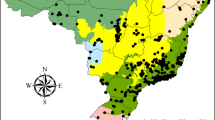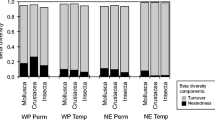Abstract.
Water beetles were examined for use as potential biodiversity indicators in continental aquatic ecosystems in a semiarid Mediterranean region, the Segura river basin (SE Spain). The indicator value of water beetles was investigated by examining the degree to which their species richness patterns was correlated with other groups (Plecoptera, Trichoptera, Mollusca, Heteroptera and Ephemeroptera), and the efficiency of water beetle area networks (selected by complementarity) in conserving overall groups richness. The species richness patterns of Coleoptera, Ephemeroptera, Plecoptera and Trichoptera were significantly correlated with the Remaining Richness value (RR), defined as the total number of species found at a site (of all six groups examined) minus the number of species belonging to the considered indicator group. Area networks for Coleoptera selected by complementarity represented the highest RR percentage (84.46%) and contained more than 78% species of each group. Furthermore, water beetles meet most of the criteria proposed in the literature for choosing biodiversity indicator taxa. In our study, the correlation values and the percentage of species represented by family, genus and species complementary networks were similar and we suggest that the higher taxa of water beetles (genera or families) can be used as biodiversity surrogates for cost-effective practical surveys.
Similar content being viewed by others
References
Abellán P., Sánchez-Fernández D., Velasco J. and Millán A. (2005). Assessing conservation priorities for insects: status of water beetles in southeast Spain. Biol. Conserv. 121: 79–90
Abellán P., Sánchez-Fernández D., Velasco J. and Millán A. in press. Conservation of freshwater biodiversity: a comparison of different area selection methods. Biodiv. Conserv.
Baldi A. (2003). Using higher taxa as surrogates of species richness:a study based on 3700 ColeopteraDipteraand Acari species in Central-Hungarian reserves. Basic Appl. Ecol. 4: 589–593
Bonada N., Zamora-Muñoz C., Rieradevall M. and Prat N. (2004). Trichoptera (Insecta) collected in Mediterranean river basins of the Iberian Peninsula: taxonomic remarks and notes on ecology. Graellsia 60: 41–69
Bournaud M., Richoux P. and Usseglio-Polaterra P. (1992). An approach to the synthesis of qualitative ecological information from aquatic coleoptera communities. Reg. Rivers: Res. Manage. 7: 165–180
Briers R.A. and Biggs J. (2003). Indicator taxa for the conservation of pond invertebrate diversity. Aquat. Conserv.: Marine Freshwater Ecosyst. 13: 323–330
Brooks T., Balmford A., Burgess N., Fjeldså J., Hansen L.A., Moore J., Rahbek C. and Williams P. (2001). Toward a blueprint for conservation in Africa. Bioscience 51(8): 613–624
Caro T.M. and O’Doherty G. (1999). On the use of surrogate species in conservation biology. Conserv. Biol. 13: 805–814
Cellot B., Dole-Olivier M.J., Bornette G. and Pautou G. (1994). Temporal and spatial environmental variability in the Upper Rhône river and its floodplain. Freshwater Biol. 31: 311–325
Davis J.A., Rolls S.W. and Balla S.A. 1987. The role of the Odonata and aquatic Coleoptera as indicators of environmental quality in wetlands. In: Majer J.D.(eds) The Role of in Invertebrates Conservation and Biological Survey. Western Australian Department of Conservation and Land Management, pp. 31–42.
Duelli P. and Obrist M.K. (2003). Biodiversity indicators: the choice of values and measures. Agri. Ecosyst. Environ. 98: 87–98
Faith D.P. and Walker P.A. (1996). How do indicator groups provide information about the relative biodiversity of different sets of areas?: on hotspots, complementarity and pattern-based approaches. Biodiv. Lett. 3: 18–25
Foster G.N. and Eyre M.D. (1992). Classification and ranking of water beetle communities. UK Nature Conservation No 1. Joint Nature Conservation Committee, Peterborough
Foster G.N., Foster A.P., Eyre M.D. and Bilton D.T. (1990). Classification of water beetle assemblages in arable fenland and ranking of sites in relation to conservation value. Freshwater Biol. 22: 343–354
Gómez R. 1988. Los Moluscos (Gastropoda y Bivalvia) de las aguas epicontinentales de la Cuenca del Río Segura (S.E. de España). Ph. D. Thesis, University of Murcia.
Halffter G., Moreno C.E. and Pineda E.O. 2001Manual para evaluación de la biodiversidad en Reservas de la Biosfera. MandT – Manuales y Tesis Sociedad Entomológica Aragonesa (SEA), Vol. 2. Zaragoza.
Heino J. (2002). Concordance of species richness patterns among multiple freshwater taxa: a regional perspective. Biodiv. Conserv. 11: 137–147
Heino J., Paavola R., Virtanen R. and Muotka T. (2005). Searching for biodiversity indicators in running waters: do bryophytes, macroinvertebrates, and fish show congruent diversity patterns?. Biodiv. Conserv. 14: 415–428
Howard P.C., Viskanic P., Davenport T.R.B., Kigenyi F.W., Baltzer M., Dickinson C.J., Lwanga J.S., Matthews R.A. and Balmford A. (1998). Complementarity and the use of indicator groups for reserve selection in Uganda. Nature 394: 472–275
Humphries C.J., Williams P.H. and Vane-Wright R.I. (1995). Measuring biodiversity value for conservation. Ann. Rev. Ecol. Syst. 26: 93–111
Huston M.A. (1994). Biological Diversity: The Coexistence of Species in Changing Landscapes. Cambridge University Press, Cambridge, UK
Jeffries M. (1988). Do water beetle communities reflect the wider freshwater community?. A trial run. Newslett. Balfour-Browne Club 42: 14–17
Kati V., Devillers P., Dufrêne M., Legakis A., Vokou D. and Lebrun Ph. (2004). Testing the value of six taxonomic groups as biodiversity indicators at a local scale. Conserv. Biol. 18: 667–675
Kerr J.T., Sugar A. and Packer L. (2000). Indicator taxarapid biodiversity assessmentand nestedness in an endangered ecosystem. Conserv. Biol. 14: 1726–1734
Kirkpatrick J.B. (1983). An iterative method for establishing priorities for the selection of nature reserves: an example from Tasmania. Biol. Conserv. 25: 127–134
Margules C.R. and Pressey R.L. (2000). Systematic conservation planning. Nature 405: 243–253
Margules C.R., Pressey R.L. and Williams PH. (2002). Representing biodiversity: data and procedures for identifying priority areas for conservation. J. Biosci. 27(2): 309–326
McGeoch M.A. (1998). The selection, testing and application of terrestrial insects as bioindicators. Biol. Rev. 73: 181–201
Médail F. and Quézel P. (1997). Hot-spots analysis for conservation of plant biodiversity in the Mediterranean basin. Ann. Missouri Bot. Garden 84: 112–127
Millán A., Velasco J., Montes C. and Nieser N. 1988. Heterópteros acuáticos (Guerromorpha & Nepomorpha) de la cuenca del Río Segura. SE. de España. Anales de Biología, 15: 33–47.
Millán A., Velasco J., Vidal–Abarca M.R., Suárez M.L. and Ramírez–Díaz L. 1996. Distribución espacial de los Adephaga acuáticos (Coleoptera) en la cuenca del río Segura (SE de la Península Ibérica). Limnetica 12(2): 13–30.
Moreno J.L., Millán A., Suárez M.L., Vidal-Abarca M.R. and Velasco J. (1997). Aquatic Coleoptera and Heteroptera assemblages in waterbodies from ephemeral coastal streams (“ramblas”) of south-eastern Spain. Archiv für Hydrobiologie 141: 93–107
Moore J.L., Balmford A., Brooks T., Burgess N.D., Hansen L.A., Rahbek C. and Williams P.H. (2003). Performance of sub-Saharan vertebrates as indicator groups for identifying priority areas for conservation. Conserv. Biol. 17: 207–218
Myers N., Mittermeier R.A., Mittermeier C.G., Da Fonseca G.A.B. and Kent J. (2000). Biodiversity hotspots for conservation priorities. Nature 403: 853–858
Noss R.F. (1990). Indicators for monitoring biodiversity: a hierarchical approach. Conserv. Biol. 4: 355–364
Paavola R., Muotka T., Virtanen R., Heino J. and Kreivi P. (2003). Are biological classifications of headwater streams concordant across diverse taxonomic groups?. Freshwater Biol. 48: 1912–1923
Panzer R., Stillwaught D., Gnaedinger R. and Derkovitz G. (1995). Prevalence of remnant dependence among the prairie and savanna in habiting insects of the Chicago region. Nat. Areas J. 15: 140–143
Paszkowski C.A. and Tonn W.M. (2000). Community concordance between the fish and aquatic birds of lakes in northern Alberta: the relative importance of environmental and biotic factors. Freshwater Biol. 43: 421–437
Pearson D.L. (1994). Selecting indicator taxa for the quantitative assessment of biodiversity. Phil. Trans. Roy. Soc. London, Series B 345: 75–79
Pearson D.L. and Cassola F. (1992). World-wide species richness patterns of Tiger Beetles (Coleoptera: Cicindelidae): indicator taxon for biodiversity and conservation studies. Conserv. Biol. 6(3): 376–390
Reyers B. and van Jaarsveld A.S. (2000). Assessment techniques for biodiversity surrogates. SA J. Sci. 96: 406–408
Ribera I. (2000). Biogeography and conservation of Iberian water beetles. Biol. Conserv. 92: 131–150
Ribera I. and Foster G. (1993). Uso de Coleópteros acuáticos como indicadores biológicos (Coleoptera). Elytron 6: 61–75
Ribera I., Hernando C. and Aguilera P. (1998). An Annotated checklist of the Iberian water beetles (Coleoptera). Zapateri 8: 43–111
Richoux P. (1994). Theoretical habitat templets, species traits and species richness: aquatic Coleoptera in the Upper Rhône River and its floodplain. Freshwater Biol. 31: 377–395
Sahlen G. and Ekestubbe K. (2001). Identification of dragonflies (Odonata) as indicators of general species richness in boreal forest lakes. Biodiv. Conserv. 10: 673–690
Sánchez-Fernández D., Abellán P., Velasco J. and Millán A. (2004a). Selecting areas to protect the biodiversity of aquatic ecosystems in a semiarid Mediterranean region. Aquat. Conserv.: Marine Freshwater Ecosyst. 14: 465–479
Sánchez-Fernández D., Abellán P., Velasco J. and Millán A. (2004b). Áreas prioritarias de conservación en la Cuenca del Río Segura utilizando los coleópteros acuáticos como indicadores. Limnética 23(3–4): 29–48
Sauberer N., Zulka K.P., Abensperg-Traun M., Berg H.M., Bieringer G., Milasowszky N., Moser D., Plutzar C., Pollheimer M., Storch C., Trostl R., Zechmeister H. and Grabherr G. (2004). Surrogate taxa for biodiversity in agricultural landscapes of eastern Austria. Biol. Conserv. 117: 181–190
Su J.C., Debinski D.M., Kajubauskas M.E. and Kindscher K. (2004). Beyond species richness: community similarity as a measure of cross-taxon congruence for coarse filter conservation. Conserv. Biol. 18(1): 167–173
Ubero-Pascal N.A. 1996. Estudio faunístico de los Órdenes Ephemeroptera y Plecoptera (Insecta) de la Cuenca del Río Segura (S.E. de la Península Ibérica). Ph.D. thesis, University of Murcia.
Vane-Wright R.I., Humphries C.J. and Williams P.H. (1991). What to protect? Systematics and the agony of choice. Biol. Conserv. 55: 235–254
Villaseñor J.L., Ibarra-Manríquez G., Meave J.A. and Ortíz E. (2004). Higher taxa as surrogates of plant biodiversity in a megadiverse country. Conserv. Biol. 19(1): 232–238
Wilcox B.A. (1984). Mc.Neely, J.A. and Miller, R. (eds) National Parks: Conservation and Development, pp 639–647. Smithsonian Institution Press, Washington DC
Williams P.H. (1996). Measuring biodiversity value. World Conserv. 1: 12–14
Williams P.H. and Gaston K.J. (1994). Measuring more of biodiversity: can higher taxon richness predict wholesale species richness?. Biol. Conserv. 67: 211–217
Williams P., Gibbons D.W., Margules C.R., Rebelo A., Humphries C.J. and Pressey R.L. (1996). A comparison of richness hotspots, rarity hotspots and complementary areas for conservation diversity of British birds. Conserv. Biol. 10(1): 155–174
Williams P.H., Gaston K.J. and Humphries C.J. (1997). Mapping biodiversity value worldwide: combining higher-taxon richness from different groups. Proc. Roy. Soc. Biol. Sci. 264: 141–148
Author information
Authors and Affiliations
Corresponding author
Rights and permissions
About this article
Cite this article
Sánchez-Fernández, D., Abellán, P., Mellado, A. et al. Are Water Beetles Good Indicators of Biodiversity in Mediterranean Aquatic Ecosystems? The Case of the Segura River Basin (SE Spain). Biodivers Conserv 15, 4507–4520 (2006). https://doi.org/10.1007/s10531-005-5101-x
Received:
Accepted:
Published:
Issue Date:
DOI: https://doi.org/10.1007/s10531-005-5101-x




